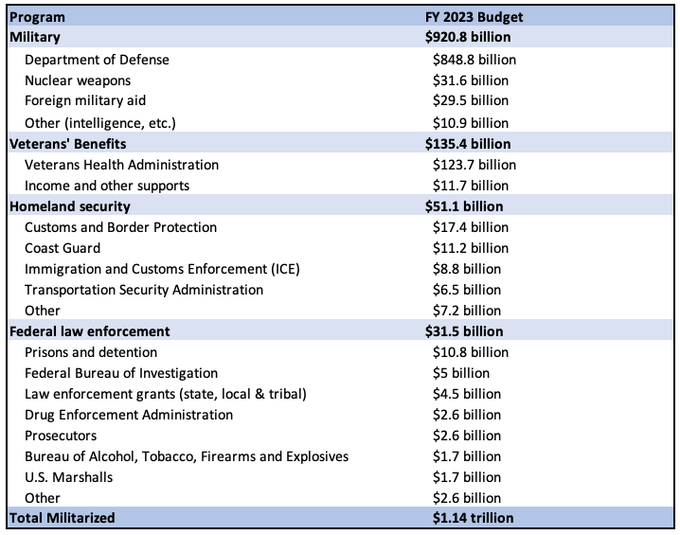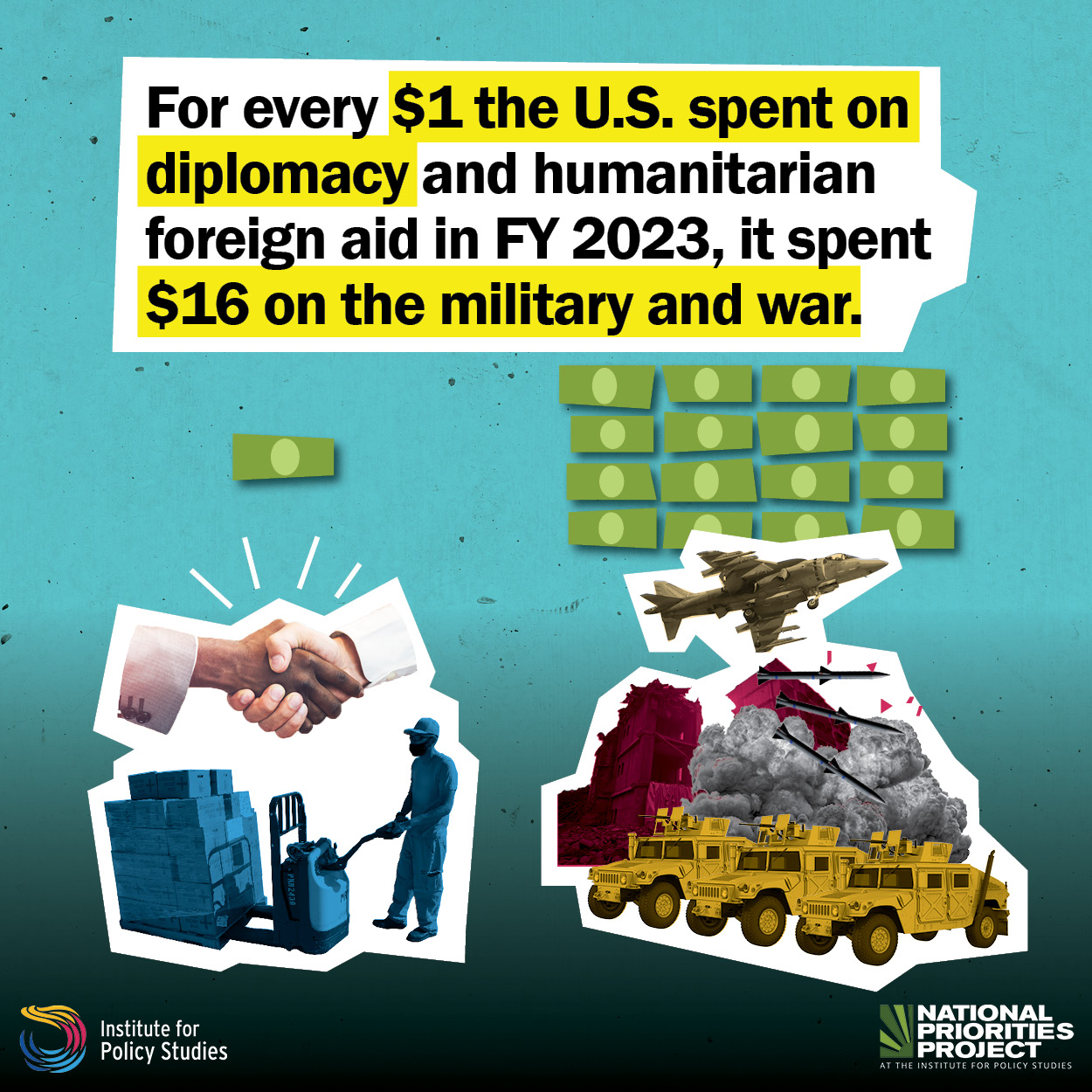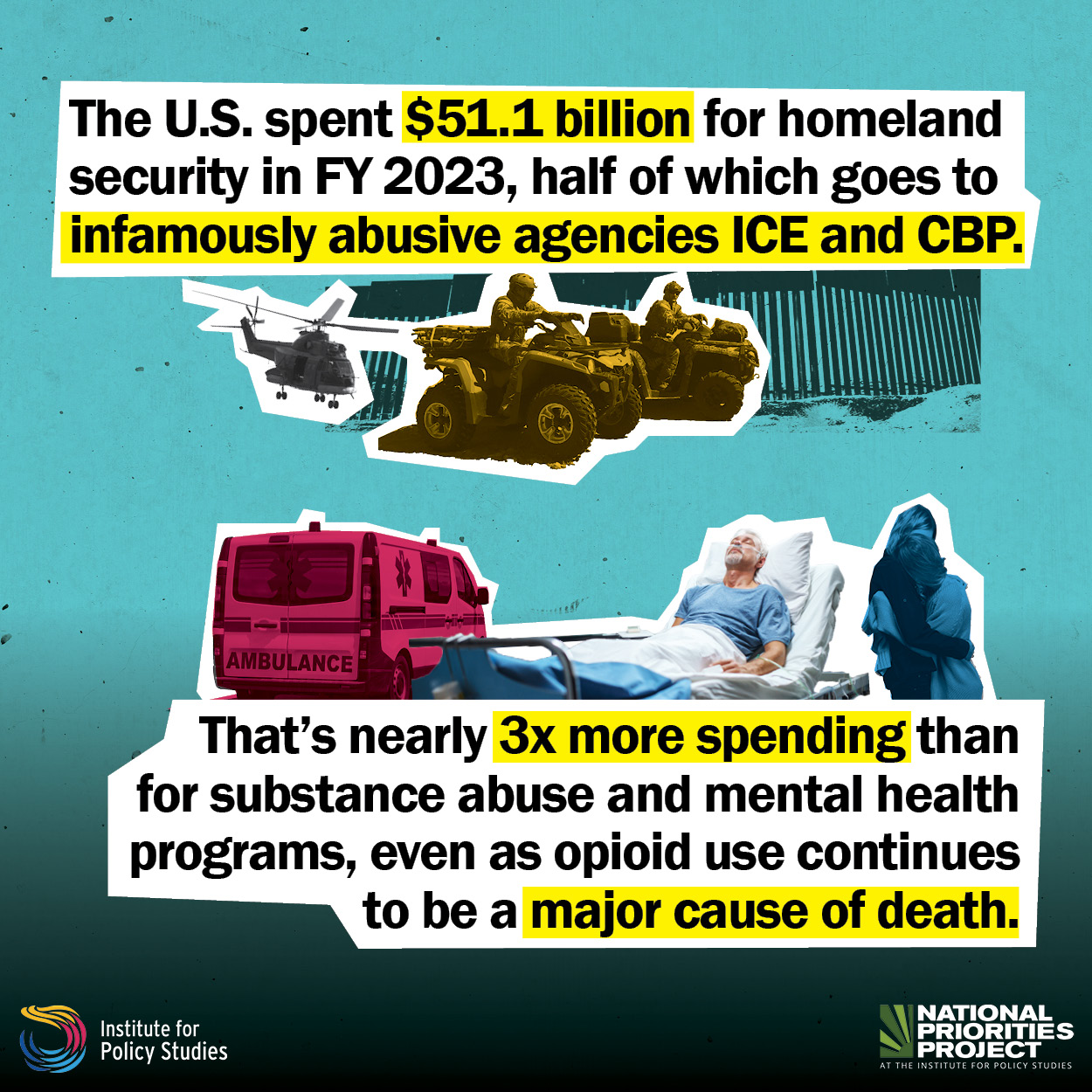The Warfare State: How Funding for Militarism Compromises Our Welfare
May 24, 2023 - Download PDF Version

Introduction
Our country’s economy faces a dire threat from so-called “fiscal conservatives,” including the present GOP House majority, who have resorted to dangerous brinkmanship to force deep cuts in the federal discretionary budget.
The discretionary budget contains the Pentagon budget as well as a number of other broadly militarized line items, including nuclear weapons, federal immigration enforcement, law enforcement, prisons, and so on. That same budget also hosts most social programs outside of Social Security, Medicare, Medicaid, and SNAP. It includes federal jobs programs, education, scientific research, and the like.
In this report, we find that the militarized portion of this budget is by far its largest single component. And yet the same legislators demanding billions in discretionary savings have vowed to exempt that militarized spending from any cuts. Instead, they’ve targeted the much smaller portion that funds human and community needs for even deeper cuts.
Below, we’ll show just how over-militarized our federal discretionary spending already is. We’ll argue that this militarized spending has done far more harm than good, while our consistent under-investment in human needs has made us much less safe. And we’ll make recommendations for getting our national priorities right in the future.
A summary of the report follows.
Read the full report here.
Key Findings
In FY 2023, out of a $1.8 trillion federal discretionary budget, $1.1 trillion — or 62 percent— was for militarized programs. That includes war and weapons, law enforcement and mass incarceration, and detention and deportation.
Less than $2 out of every $5 in federal discretionary spending was available to fund investment in people and communities, including primary and secondary public education, housing programs, child care programs, federal disaster relief, environmental programs, and scientific research.
The U.S. spent $16 on the military and war for every $1 that was spent on diplomacy and humanitarian foreign aid.
-
The vast majority of militarized spending was for weapons, war and the Pentagon, at $920 billion.
-
Only $56 billion was spent for international affairs, diplomacy, and humanitarian foreign aid.
The U.S. spent $51.1 billion for homeland security, approximately half of which goes to ICE ($8.8 billion) and CBP ($17.4 billion), the agencies responsible for deportations, family separations, and violent apprehension at the southern border.
-
That’s nearly three times spending on substance abuse and mental health programs ($7.5 billion), even as opioid use remains a major cause of death.
The U.S. federal budget allocated twice as much for federal law enforcement, which includes federal prisons, the FBI and other law enforcement agencies ($31 billion), as for child care and early childhood education programs ($15 billion).
Since 2001, the U.S. has added $2 to the discretionary budget for militarism for every $1 added to invest in communities.
-
Spending on care for veterans has nearly tripled since 2001, following 20 years of war, repeated deployments for the 3 million veterans who served in the post-9/11 wars, and rampant physical and mental health needs of returning veterans.
-
Spending on homeland security (excluding FEMA) has more than doubled since 2001, and spending on the military and nuclear weapons has grown by 80 percent, in inflation-adjusted terms.
Militarism Mania
Here are the militarized federal programs that together account for nearly two-thirds of all discretionary spending.

Source: Office of Management and Budget
And here’s how those programs compare to everything else in the discretionary budget.

Source: Office of Management and Budget
These lopsided figures reflect the tremendous militarization of the federal budget in the more than two decades since the 9/11 terrorist attacks.

Figures are in 2023 dollars. Source: Office of Management Budget.
Redefining Security
Spending on the military and homeland security has too often failed to meaningfully contribute to security.
The post-9/11 “war on terror,” for example, has cost more than $8 trillion and contributed to a horrific death toll of 4.5 million people in affected regions. Meanwhile, a U.S. military budget that outpaces Russia’s by more than 10 to 1 has failed to prevent or end the Russian war in Ukraine.
Similarly, vast investments in “border security” and a huge deportation apparatus have failed to produce a functional immigration system while harming millions of families. And federal law enforcement, including the war on drugs, has contributed to the world’s largest incarcerated population while failing to control addiction or reduce overdose deaths.
The harm these programs have done is compounded by the parallel failure to invest in other urgent needs and crises. For example:
-
The Department of Homeland Security received more than seven times the funding for the Centers for Disease Control over the past 20 years, contributing to the underpreparedness that allowed the U.S. to reach 1.1 million deaths due to the COVID-19 pandemic.
-
For what the U.S. spent on our military during the 9/11 wars, we could have invested in a fully renewable national electric grid to slow the effects of climate change — nearly four times over.
-
Likewise, road, rail, and air traffic safety programs show signs of underinvestment, as became apparent during the FAA system outage that grounded thousands of flights, or the toxic threat created by a train derailment in East Palestine, Ohio.
-
And many K-12 public schools that are already facing staffing shortages and a student mental health crisis are dependent on federal aid to provide a bulwark against the heavily local, unequal funding provided by cities and states.
In fact, in the past 20 years, the only time that discretionary funding for non-militarized programs equaled the militarism budget was at the height of the COVID pandemic, when Congress enacted billions to stem the dual health and economic crises. Congress has now ended those programs.
Recommendations
1. Immediately reduce the budget for the Pentagon and nuclear weapons by $100 billion or more, and reinvest the savings in non-militarized discretionary priorities. There are multiple paths to achieve these savings while keeping Americans safe.
-
The Congressional Budget Office found that the U.S. military could achieve $100 billion in savings without changing the country’s national security strategy. The military budget has grown substantially since this estimate, meaning real potential for cuts could be greater.
-
A Department of Defense study found $125 billion in unnecessary back-office expenses (and the Pentagon buried the report) that could be trimmed.
-
Even Pentagon leaders have called for divesting from wasteful, ineffective, or dangerous weapons like the F-35 jet fighter, the Littoral Combat Ship, and planned reinvestment in nuclear weapons. Savings could reach trillions over the next several decades.
-
The U.S. has more than 750 military installations in more than 80 countries around the world, many dating as far back as World War II. Closing bases that support authoritarian governments, those that are opposed by local residents, and those that serve questionable security purposes could save billions.
-
Reduce reliance on contractors, who account for half of the Pentagon budget each year. Studies have shown that Pentagon contractors provide the same services at a higher cost than government workers.
2. Make any future Pentagon spending increases contingent on the Department of Defense passing an audit. The Department of Defense is the only major federal agency never to pass an audit. It’s failed five in a row.
3. Increase congressional oversight to make it harder for the U.S. to go to war and accrue war debt. Two military force authorization votes in the early aughts led the U.S. into 20 years of war, at a cost of $8 trillion, and cost many veterans and their families their stability and health. Existing authorizations should be repealed and future ones should be subject to much greater scrutiny.
4. Restructure the country’s immigration system to support robust legal immigration and current undocumented residents — and cut spending for structures that are built to deter immigration and deport immigrants, including Customs and Border Protection and Immigration and Customs Enforcement.
5. End federal support for racist and counterproductive carceral and policing practices, including the war on drugs. Reinvest in alternatives including anti-poverty programs, community support and mental health services, and substance use support programs.



